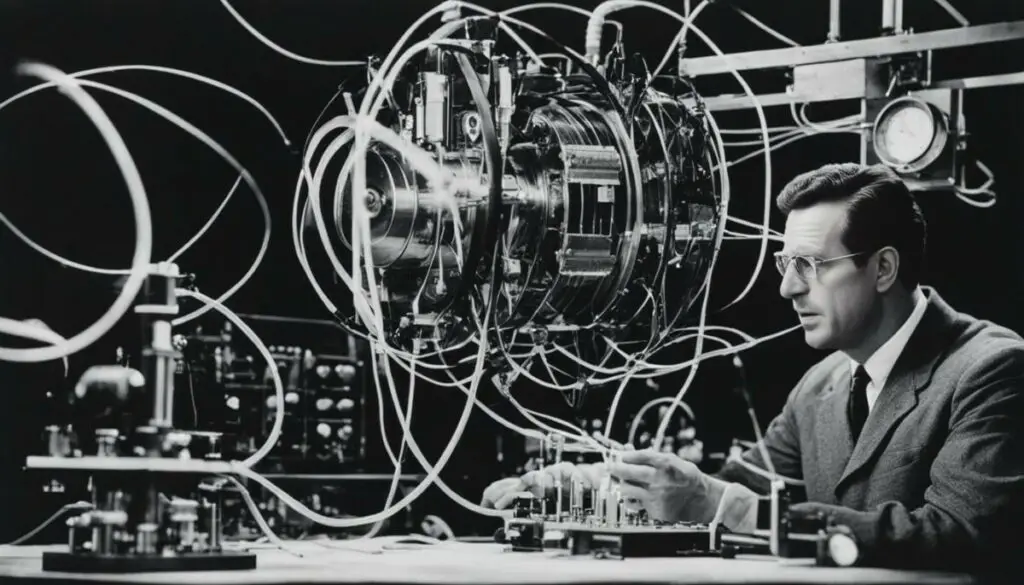Last Updated on 4 months by Francis
Welcome to our article on infrared waves! Have you ever wondered if infrared waves are electromagnetic or transverse? In this section, we will explore the nature of infrared waves and shed light on this intriguing question.
Infrared waves are a type of electromagnetic wave, just like radio waves, microwaves, visible light, ultraviolet rays, X-rays, and gamma rays. They are composed of oscillating magnetic and electric fields that propagate through space. With longer wavelengths than visible light, ranging from 700 nanometers to 1 millimeter, infrared waves have their own unique characteristics and applications.
Contents
Key Takeaways:
- Infrared waves are a type of electromagnetic wave.
- They have longer wavelengths than visible light.
- Infrared waves can be classified based on their wavelength ranges.
- They are used in various applications, including heating and thermal imaging.
- Advancements in infrared technology continue to expand its uses and possibilities.
What Are Electromagnetic Waves?

Electromagnetic waves, an integral part of the vast electromagnetic spectrum, signify a form of energy that propagates through space. These waves manifest as oscillating electric and magnetic fields, encompassing various frequencies and characteristics. In addition to infrared waves, which we explored in the previous section, the electromagnetic spectrum includes an array of waves, such as radio waves, microwaves, visible light, ultraviolet rays, X-rays, and gamma rays.
Each type of electromagnetic wave has distinct properties, depending on its wavelength, frequency, and energy level. These waves play a significant role in numerous scientific, technological, and everyday applications. Understanding the nature and behavior of electromagnetic waves is vital in comprehending the diverse phenomena they govern.
However, in this section, we will delve deeper into the world of electromagnetic waves, exploring their intricate features and the wide range of waves they encompass.
To provide a clearer visual understanding, let’s take a look at the electromagnetic spectrum:
The Electromagnetic Spectrum
| Wave Type | Wavelength Range | Frequency Range | Energy Range |
|---|---|---|---|
| Radio Waves | 1 millimeter – 100 kilometers | 3 kilohertz – 300 gigahertz | Low |
| Microwaves | 1 millimeter – 1 meter | 300 megahertz – 300 gigahertz | Low to medium |
| Visible Light | 380 – 700 nanometers | 430 terahertz – 750 terahertz | Medium |
| Ultraviolet Rays | 10 – 380 nanometers | 750 terahertz – 30 petahertz | Medium to high |
| X-rays | 0.01 – 10 nanometers | 30 petahertz – 30 exahertz | High |
| Gamma Rays | Less than 0.01 nanometer | More than 30 exahertz | Very high |
Note: The values mentioned above are approximate and may vary depending on different sources and applications.
The electromagnetic spectrum encompasses a vast range of frequencies and wavelengths, allowing for diverse applications across multiple fields. By understanding the characteristics and behaviors of electromagnetic waves, scientists and technologists can harness their power and unlock a world of possibilities.
Characteristics of Infrared Waves

Infrared waves possess several unique characteristics that distinguish them from other types of waves. Understanding these properties is essential for comprehending the applications and significance of infrared radiation.
- Thermal Waves: Infrared waves are known as thermal waves because they are closely associated with heat generation. This property makes them instrumental in various applications, including the operation of infrared heaters and therapeutic treatments that require controlled heat production.
- Near-Infrared and Far-Infrared: Infrared waves can be classified into two categories: near-infrared and far-infrared. The categorization depends on their wavelength ranges and the specific applications they serve. Near-infrared waves are commonly used in electronic devices like TV remote sensors and have shorter wavelengths. Conversely, far-infrared waves have longer wavelengths and are predominantly emitted by objects that generate heat, exhibiting more thermal characteristics.
- Transverse Wave Properties: Infrared waves exhibit transverse wave properties, manifesting as oscillations of the electric and magnetic fields that are perpendicular to the direction of wave propagation. This transverse nature allows infrared waves to efficiently transmit energy while also enabling various phenomena such as reflection, refraction, and interference.
By understanding these characteristics, researchers, scientists, and engineers can harness the unique properties of infrared waves for numerous applications across diverse fields.
| Characteristic | Description |
|---|---|
| Thermal Waves | Infrared waves are thermal waves associated with heat generation and utilization. |
| Near-Infrared and Far-Infrared | Infrared waves can be classified as near-infrared and far-infrared, depending on their wavelengths and applications. |
| Transverse Wave Properties | Infrared waves exhibit transverse wave properties, with oscillations of electric and magnetic fields perpendicular to the direction of wave propagation. |
The Discovery of Infrared Radiation

In 1800, the British astronomer William Herschel made a groundbreaking discovery that would revolutionize our understanding of electromagnetic radiation. While conducting an experiment to measure the temperature difference between different colors of the visible spectrum, Herschel noticed something unexpected. Beyond the red end of the spectrum, he observed an increase in temperature, despite the absence of visible light.
Fascinated by this peculiar phenomenon, Herschel conducted further experiments and made a significant realization. The invisible radiation responsible for the temperature increase possessed unique properties and could induce heat. To describe this newfound radiation, Herschel coined the term “infrared,” combining the Latin words “infra,” meaning below, and “red,” referencing its position beyond the red end of the visible spectrum.
“The sun’s rays, these invisible thermal rays, are so plentiful outside the red part of the spectrum that it has a most remarkable heating effect.”
With his discovery, Herschel opened the door to a new realm of exploration and laid the foundation for the study of infrared radiation. Scientists and researchers delved deeper into the nature and applications of these unseen waves, uncovering their vast potential in a variety of fields.
Unveiling the Heat Beyond the Visible
Infrared radiation’s ability to generate heat prompted further investigations into its unique properties. Scientists discovered that infrared waves had longer wavelengths than visible light, enabling them to penetrate certain materials and interact with our surroundings in profound ways. The pioneering work of Herschel served as a springboard for subsequent advancements in understanding and harnessing this form of electromagnetic radiation.
Today, we continue to build upon Herschel’s legacy, uncovering new applications and pushing the boundaries of what is possible with infrared technology. From heat production to medical treatments, infrared waves have proven to be an invaluable tool in various industries and scientific endeavors.
The Legacy of William Herschel
William Herschel’s groundbreaking discovery of infrared radiation left an indelible mark on the scientific community. In addition to his contributions to astronomy, his exploration of the invisible world of infrared waves paved the way for significant advancements in diverse fields, from communication to thermal imaging.
Thanks to Herschel’s curiosity and ingenuity, we have come to understand the far-reaching influence of infrared radiation. Today, we continue to explore this fascinating form of electromagnetic energy, unlocking its secrets and leveraging its unique properties to enhance our lives and expand human knowledge.
Wavelength and Frequency of Infrared Waves

In the world of electromagnetic waves, understanding the wavelength and frequency of infrared waves is crucial. These properties define the characteristics and behavior of infrared radiation, impacting its applications in various fields.
Wavelength
The wavelength of infrared waves ranges from 700 nanometers to 1 millimeter. In simpler terms, wavelength is the distance between consecutive points in a wave that are in phase. For infrared waves, it represents the distance between successive peaks or troughs of the wave. This measurement determines the color and energy of the radiation, with shorter wavelengths corresponding to higher energy levels and vice versa.
Frequency
The frequency of infrared waves is inversely proportional to their wavelength and follows the equation speed = frequency * wavelength. Higher frequency waves have shorter wavelengths and carry more energy, while lower frequency waves have longer wavelengths and lower energy levels. In the case of infrared waves, their frequencies fall within a specific range determined by their wavelengths.
Electromagnetic Spectrum
Infrared waves occupy a unique position within the electromagnetic spectrum, positioned between visible light and microwaves. This spectrum encompasses a wide range of waves, each with its own distinct wavelength and frequency characteristics. By understanding the specific wavelength and frequency of infrared waves, scientists and researchers can harness their properties for diverse applications.
Visual representation:
Regions of Infrared and Their Characteristics
Infrared waves can be categorized into different regions based on their wavelengths. These regions include near-infrared, short-wavelength infrared, mid-wavelength infrared, long-wavelength infrared, and far-infrared. Each region has its own unique characteristics and applications.
- Near-infrared: This region of infrared waves has wavelengths ranging from 700 to 1400 nanometers. It is commonly used in material science for spectroscopic analysis, as well as in fibre optic communication for data transmission. Near-infrared also finds applications in the medical field for non-invasive diagnostic imaging and monitoring.
- Short-wavelength infrared: With wavelengths ranging from 1400 to 3000 nanometers, short-wavelength infrared is often utilized in telecommunications and military purposes. It offers advantages such as low atmospheric absorption and can be used for short-range data communication and night vision devices.
- Mid-wavelength infrared: This region spans from 3000 to 8000 nanometers in terms of wavelength. It finds applications in various industries, including the chemical industry, where it is used for monitoring chemical reactions and analyzing complex compounds. In astronomy, mid-wavelength infrared enables researchers to study celestial objects obscured by dust and gas clouds.
- Long-wavelength infrared: With wavelengths ranging from 8000 to 15000 nanometers, long-wavelength infrared is crucial for astronomical observations and telecommunications. It allows astronomers to observe objects that emit infrared radiation, including distant galaxies. In telecommunications, it is used for long-range data transmission.
- Far-infrared: This region extends from 15000 to 100,000 nanometers in terms of wavelength and is mainly used in cancer therapy. Far-infrared waves have the ability to penetrate deep into the skin, providing therapeutic benefits such as pain relief, relaxation, and improved blood circulation.
Table: Applications of Different Infrared Regions
| Region | Applications |
|---|---|
| Near-infrared | Material science, fibre optic communication, medical imaging |
| Short-wavelength infrared | Telecommunications, military applications, night vision devices |
| Mid-wavelength infrared | Chemical industry, astronomy, spectroscopy |
| Long-wavelength infrared | Astronomical observations, long-range telecommunications |
| Far-infrared | Cancer therapy, pain relief, relaxation |
Properties of Infrared Waves

Infrared waves possess several unique properties that set them apart from other types of waves. Understanding these properties is crucial to unlocking the many applications of infrared radiation.
Transverse Waves
Infrared waves are classified as transverse waves. This means that the oscillations of the electric and magnetic fields occur perpendicular to the direction of wave propagation. The illustration below demonstrates this perpendicularity:
“Infrared waves are transverse waves, characterized by the oscillations of electric and magnetic fields that occur perpendicular to the direction of wave propagation.”
Refraction, Reflection, and Interference
Similar to other waves, infrared waves exhibit the phenomena of refraction, reflection, and interference. Refraction occurs when infrared waves pass through a medium and change direction due to a change in their speed. Reflection occurs when infrared waves bounce off a surface, changing their direction but not their speed. Interference happens when two or more infrared waves meet and combine, resulting in either constructive or destructive interference depending on their phase alignment.
These properties of refraction, reflection, and interference allow scientists and engineers to manipulate infrared waves for various applications. By understanding how these phenomena affect infrared radiation, researchers can design materials and devices that harness and control infrared energy.
Absorption and Thermal Properties
Infrared waves have the remarkable ability to be absorbed by certain substances, such as ozone, carbon dioxide, and water vapor. When infrared waves are absorbed, they transfer their energy to the absorbing material, causing heating effects. This thermal property of infrared waves is the cornerstone of many applications in heating, therapeutic treatment, and imaging.
The absorption characteristics of infrared waves also enable the development of technologies like infrared spectroscopy, where the absorption patterns of infrared radiation by different materials are used for chemical analysis.
| Infrared Wave Properties | Summary |
|---|---|
| Transverse Waves | Infrared waves are transverse waves, with oscillations perpendicular to the direction of wave propagation. |
| Refraction, Reflection, and Interference | Infrared waves can undergo refraction, reflection, and interference, allowing control and manipulation of the radiation. |
| Absorption and Thermal Properties | Infrared waves can be absorbed by certain substances, transferring their energy and generating heat. |
These properties make infrared waves invaluable in various fields, including communication, heating, healthcare, and scientific research. The ability to harness and utilize these unique properties continues to drive advancements in infrared technology and expand its applications.
Uses and Applications of Infrared Waves

Infrared waves have a wide range of applications across various fields, harnessing their unique properties to serve different purposes. Let’s explore some of the key applications of infrared radiation:
1. Heat Source
Infrared waves are utilized as a heat source in numerous industries, including manufacturing, construction, and agriculture. Industrial processes often rely on the efficient transfer of heat, and infrared waves provide a reliable and effective method for generating and transferring heat. Infrared heaters are commonly used in drying applications, curing coatings, and maintaining desired temperatures in controlled environments.
2. Cosmetology
In cosmetology, infrared waves are employed for various skin treatments and therapeutic purposes. The deep-penetrating nature of infrared waves allows for effective skin rejuvenation, reducing wrinkles, and promoting collagen production. Infrared therapy can also improve blood circulation, providing relief for muscle and joint pain. Many beauty and wellness centers offer infrared sauna treatments to enhance relaxation and detoxification.
3. Astronomy
Astronomers heavily rely on infrared waves to observe celestial objects and gather vital information about the universe. Infrared radiation can pass through cosmic dust that may obstruct visible light observations. By studying infrared light emitted by celestial bodies, astronomers can unveil hidden details, such as the formation of stars, the presence of exoplanets, and the composition of celestial atmospheres.
4. Massage Therapy
Infrared waves are often incorporated into massage therapy to enhance the therapeutic benefits. The deep, gentle heat generated by infrared waves can relax muscles, relieve tension, and improve blood circulation. This aids in reducing soreness, promoting healing, and providing a soothing, rejuvenating experience for individuals seeking relief from muscle pain and stress.
5. Infrared Photography
Infrared photography utilizes specialized cameras and filters to capture stunning images by detecting infrared radiation. By focusing on the infrared spectrum, photographers can create unique visual effects, transforming landscapes, architecture, and nature scenes into ethereal and surreal compositions. Infrared photography offers a fresh perspective, revealing hidden details and capturing the world in a captivating way.
6. Infrared Communication
Infrared waves serve as a means of communication over short distances. Infrared communication technology is commonly employed in devices such as remote controls, infrared data transfer, and proximity sensors. This technology enables the wireless transmission of data between devices reliably and securely, finding applications in home entertainment systems, mobile devices, and various electronic gadgets.
As we delve deeper into the potential of infrared waves, we continue to discover new and innovative applications across different industries and scientific fields. The versatility of infrared radiation opens up possibilities for advancements and breakthroughs that can further enhance our understanding of the world and improve our quality of life.
Advancements in Infrared Technology
Continual advancements in infrared technology have paved the way for new and improved applications in various industries. Infrared cameras and sensors are now widely utilized in security, surveillance, automotive, and healthcare sectors, revolutionizing the way we gather information and ensure safety.
One of the key breakthroughs in infrared technology is infrared imaging, which enables the detection of heat signatures. This capability has proven invaluable in search and rescue operations, allowing rescuers to locate individuals even in low visibility or hazardous conditions. Additionally, infrared imaging plays a crucial role in building inspections, where it can identify thermal anomalies and potential faults within structures. In the field of medical diagnostics, infrared imaging assists healthcare professionals in identifying areas of inflammation or infection by detecting differences in skin temperature.
Infrared spectroscopy is another area where significant progress has been made. This technique utilizes infrared light to analyze the composition and molecular structure of substances in various fields, including chemical analysis and materials research. By studying the absorption and reflection of infrared light, scientists gain insights into the chemical bonds and functional groups present in a sample, leading to a better understanding of its characteristics and behaviors.
Moreover, infrared technology has integrated into consumer products, enhancing our daily lives. Smart home devices, such as infrared-enabled thermostats and security systems, allow homeowners to control temperature and monitor their property remotely. Temperature monitoring systems equipped with infrared sensors are also in demand, providing accurate and non-contact temperature measurement in industrial and medical settings. Furthermore, infrared technology is widely used in remote controls, enabling seamless wireless communication with various electronic devices.
“The advancements in infrared technology have opened up new possibilities and applications across industries. From enhanced security and surveillance to improved diagnostics and convenience in consumer products, the impact of infrared technology continues to broaden.”
Ongoing advancements in infrared technology hold immense promise for future innovations. As scientists and engineers push the boundaries of what is possible, we can expect to see even more advanced infrared cameras, sensors, and imaging techniques. These developments will not only improve the accuracy and reliability of existing applications but also uncover new realms of possibilities, revolutionizing how we interact with our surroundings and enhance our quality of life.
Conclusion
In conclusion, infrared waves are a form of electromagnetic radiation that falls within the infrared region of the electromagnetic spectrum. These waves have unique characteristics that make them versatile and valuable in various applications.
One of the key properties of infrared waves is their thermal nature. They have the ability to produce heat and are widely used in heating systems, cosmetology treatments, and therapeutic applications.
Infrared waves also exhibit a transverse wave nature, with oscillations of the electric and magnetic fields perpendicular to the direction of wave propagation. This property enables their efficient transmission and allows for applications such as infrared communication and data transmission.
Furthermore, infrared waves have the ability to penetrate certain substances, which makes them ideal for applications in astronomy, where they can penetrate cosmic dust and provide valuable insights into celestial objects. They are also used in medical diagnostics, building inspections, and security systems.
As advancements in infrared technology continue, we can expect even more exciting applications and innovations in the future. The versatility and unique properties of infrared waves solidify their place as an integral part of our technological landscape.
FAQ
Are infrared waves electromagnetic or transverse?
Infrared waves are a type of electromagnetic wave that exhibits transverse wave properties.
What are electromagnetic waves?
Electromagnetic waves are a form of energy that propagate through space in the form of oscillating electric and magnetic fields. They encompass a wide range of frequencies, including infrared waves, radio waves, microwaves, visible light, ultraviolet rays, X-rays, and gamma rays.
What are the characteristics of infrared waves?
Infrared waves have longer wavelengths than visible light and are thermal waves associated with heat production. They can be classified into regions based on their wavelengths, such as near-infrared, short-wavelength infrared, mid-wavelength infrared, long-wavelength infrared, and far-infrared. In addition, they exhibit transverse wave properties with oscillations perpendicular to the direction of wave propagation.
Who discovered infrared radiation?
Infrared radiation was discovered by the British astronomer William Herschel in 1800.
What is the wavelength and frequency of infrared waves?
The wavelength of infrared waves ranges from 700 nanometers to 1 millimeter. The frequency of infrared waves is inversely proportional to their wavelength.
What are the regions of infrared and their characteristics?
Infrared waves can be categorized into different regions based on their wavelengths. These regions include near-infrared, short-wavelength infrared, mid-wavelength infrared, long-wavelength infrared, and far-infrared. Each region has its own unique characteristics and applications.
What are the properties of infrared waves?
Infrared waves are transverse waves, meaning the oscillations of the electric and magnetic fields are perpendicular to the direction of wave propagation. They can be absorbed by certain substances, exhibit refraction, reflection, and interference characteristics, and possess thermal properties that generate or transfer heat when interacting with matter.
What are the uses and applications of infrared waves?
Infrared waves have a wide range of uses and applications. They are used as a heat source in various industries, for cosmetology treatments, in astronomy for studying celestial objects, in massage therapy, infrared photography, and infrared communication for data transmission over short distances.
What are the advancements in infrared technology?
Advancements in infrared technology have led to the development of infrared cameras, sensors, and spectroscopy techniques. These technologies find applications in security, surveillance, automotive, healthcare, and more, allowing for the detection of heat signatures, building inspections, medical diagnostics, chemical analysis, and materials research.
What are the key points about infrared waves?
Infrared waves are a form of electromagnetic radiation that falls within the infrared region of the electromagnetic spectrum. They have unique characteristics, applications, and properties, including thermal properties, transverse wave nature, and the ability to penetrate certain substances. Ongoing advancements promise further innovations and applications in the future.









